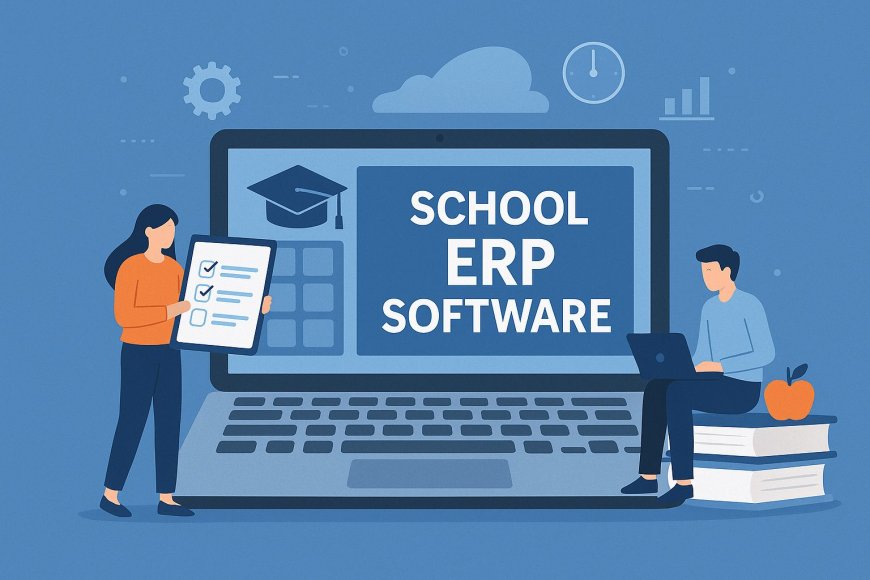Know Everything, Control Everything — In One ERP
This article explores the key benefits of ERP systems in schools, from data centralization and decision-making to security and scalability, helping administrators take full control with one powerful solution.

In today’s fast-paced digital world, the ability to centralize and streamline information is no longer a luxury—it's a necessity. For educational institutions, managing a growing body of administrative tasks, student data, and academic processes requires an advanced yet intuitive solution. This is where school ERP software comes into play, offering a single, integrated system that empowers school administrators, teachers, students, and parents alike. The goal is clear: know everything and control everything—all in one ERP.
What is an ERP System for Schools?
ERP stands for Enterprise Resource Planning, a system originally designed for managing business operations. In the context of education, ERP systems have evolved into comprehensive platforms that integrate academic, administrative, and financial functions. From admissions and attendance to examinations and payroll, a school ERP brings every department under one digital roof.
Unlike disjointed tools and paper-based processes, an ERP creates a seamless flow of information between departments, ensuring accuracy, accountability, and efficiency.
The Centralized Power of Integration
One of the primary advantages of a school ERP system is data centralization. Traditionally, schools manage their information across multiple platforms—spreadsheets for attendance, paper files for student records, and emails for communication. This fragmentation not only wastes time but also increases the risk of human error.
With an ERP, all this information is stored and accessible in a single database. Administrators can track student progress, monitor teacher performance, manage fees, and even communicate with parents from one dashboard. For example, if a teacher updates a student’s marks in the system, those updates can immediately be reflected in report cards and visible to parents via the parent portal—no duplication of work required.
This integration also simplifies compliance and reporting. Government audits or accreditation reviews can be completed more easily with accurate, well-documented records generated directly from the ERP.
Real-Time Insights and Decision-Making
Another compelling benefit of ERP software is real-time data accessibility. Decision-makers no longer have to wait days or weeks to get updated reports. Whether it’s tracking attendance trends, analyzing student performance, or forecasting budget requirements, the ERP provides actionable insights through real-time dashboards and analytics tools.
For school administrators, this means better planning and quicker problem-solving. For instance, if absenteeism spikes in a particular class, the system can flag it instantly, prompting timely intervention. Similarly, financial officers can monitor tuition payments and generate financial reports without relying on manual reconciliation.
Enhanced Communication and Collaboration
Efficient communication is the backbone of any thriving institution. ERP systems facilitate transparent and timely communication among stakeholders—teachers, students, parents, and management.
With features like automated notifications, messaging platforms, and discussion boards, everyone stays in the loop. Parents can receive real-time updates on their child's academic progress, behavior, and attendance. Teachers can collaborate on lesson plans, share resources, and discuss student issues in a secure environment.
This increased collaboration fosters a community-oriented school culture and reduces misunderstandings or communication gaps.
Security and Data Privacy
Data privacy has become a growing concern in educational environments, especially with the rising cases of cyberattacks. A high-quality ERP system prioritizes data security, incorporating encryption, role-based access, and secure hosting environments.
Reputable providers also offer data backups and disaster recovery features, ensuring that student and staff information is protected even in the event of technical issues. Schools can choose between on-premise or cloud-based solutions, depending on their infrastructure and security preferences.
Customization and Scalability
Every educational institution is unique. A good ERP system respects this by offering modular design and customization options. Whether a school wants to integrate transportation tracking, library management, or hostel facilities, the ERP can be tailored to its needs.
Moreover, as institutions grow—expanding campuses, adding courses, or accommodating more students—the ERP scales effortlessly without disrupting operations. This makes it a long-term investment with high returns in operational efficiency.
Selecting the Right ERP: What to Look For
Choosing the right school ERP software requires careful consideration. Some key factors to evaluate include:
User Interface: Is the platform intuitive and easy for non-tech-savvy users?
Support and Training: Does the vendor offer ongoing support and staff training?
Integration Capabilities: Can it integrate with other systems like LMS, biometric devices, or accounting software?
Cost-effectiveness: Does the ERP offer value for money relative to its features?
Consulting with stakeholders—teachers, IT staff, and administrative heads—can help ensure that the chosen solution aligns with the institution’s specific needs.
Final Thoughts
In an increasingly digital world, the importance of having a unified system to manage all aspects of school operations cannot be overstated. A robust ERP not only simplifies administrative burdens but also enhances transparency, collaboration, and informed decision-making. By choosing the right school ERP software, institutions can truly know everything that happens within their ecosystem—and control it from one centralized platform.
This isn’t just about automation; it’s about empowerment. And in education, that makes all the difference.





























































































































![Are AI Chatbots Replacing Search Engines? AI vs Google [New Research]](https://www.orbitmedia.com/wp-content/uploads/2025/05/How-often-are-we-using-AI-chatbots_.webp)
































